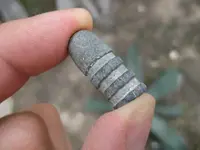After I posted, I got to thinking I should have added that the 405 grain 45-70 bullet was used by the army even after the 500 grain rifle bullet was adopted. The carbine continued to be loaded with the 405 grain bullet for years. That bullet was used even after the .30-40 Krag was adopted and used in the Spanish-American war, and in fact National Guard Units were armed with the 1873 Springfield in 45-70 caliber during WWI, but they weren't sent overseas. Also, the cartridge was loaded by civilian ammunition manufactures, as well as civilian rifles were chambered for for that caliber. The .50-90 Sharps is touted as the "buffalo gun," but the 45-70 also played a role in the near extinction of the buffalo. The 7th cavalry was armed with 45-55 carbines at the Little Big Horn in 1876, and the following year, the army fought the Nez Perece using the 45-70, and the Nez Perce captured a lot of carbines along with loaded pack animals of ammo, so the army was being fought against in part with their own guns.
I think I can see rifling grooves in your bullet, and if that is the case, it was near terminal velocity when it landed, because it doesn't look deformed at all. Trust me, those bullets hit hard and are really banged up when they hit at closer ranges.
By the way, welcome to TNet, in what context did you find the bullet? General area, you don't have to be specific, just curious if you were on the plains of Montana or Wyoming, or back east some where. The buffalo hunters would cast bullets and re-load their brass.




